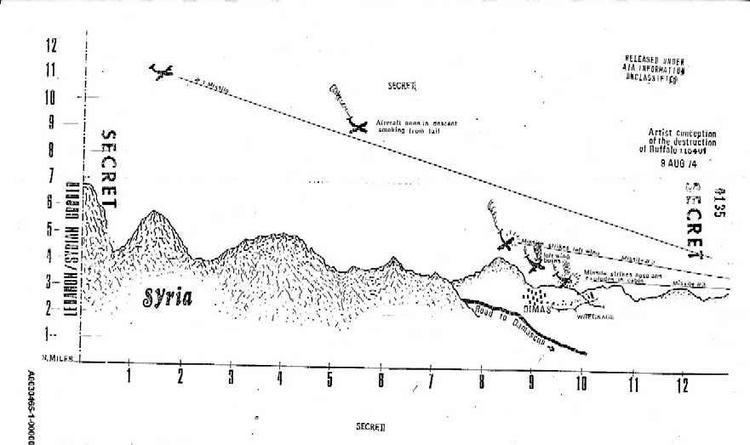Summary Shot down by missiles Passengers 4 Fatalities 9 Date 9 August 1974 Injuries (nonfatal) 0 Survivor 0 | Crew 5 Survivors 0 Number of deaths 9 Operator Canadian Armed Forces | |
 | ||
Similar 1974 Norfolk mid‑air co, Turkish Airlines Flight 301, Air Vietnam Flight 706 hijacking, 1974 Togo plane crash, Pan Am Flight 806 | ||
Buffalo 461 was a Canadian military de Havilland Canada DHC-5 Buffalo assigned to the second United Nations Emergency Force force in Syria in support of United Nations Security Council Resolution 340. Assigned to a peacekeeping force, Buffalo 461 was shot down by three Syrian missiles on August 9, 1974 killing all nine passengers and crew.
Contents
The loss of Buffalo 461 remains both the largest single-incident loss of life in the history of Canadian peacekeeping operations and was the most recent Canadian Forces aircraft shot down while in service until a Chinook helicopter was downed on operations in Kandahar, Afghanistan in August 2010.
UN Flight 51
The second United Nations Emergency Force was authorized by the United Nations Security Council to supervise the ceasefire between Egypt and Israel following the end of the October War. Besides preventing additional flare-ups of fighting, the peacekeeping force was also tasked with assisting the Red Cross with humanitarian efforts in the region. Canada was a leader in these peacekeeping efforts and was providing logistics, signals and air and service units. Their three Buffalo aircraft were flying six-day-a-week schedules.
UN Flight 51 was Buffalo 461's last flight designation, for a routine scheduled supply trip from Ismailia, Egypt to Damascus, Syria. Five crew members and four military passengers were on board when the aircraft took off from Beirut International Airport after a stopover. The First Officer, Captain Keith Mirau, received clearance to enter Syrian airspace from the Damascas air traffic control centre at 0945 GMT. Shortly after crossing from Lebanon into Syria the plane was hit by a surface-to-air missile launched from a Syrian airfield. Moments later two more missiles struck and destroyed the plane, scattering wreckage across a field near the Syrian town of Ad Dimas. All nine on board were killed.
Aircraft
The aircraft, the 16th Buffalo built, first flown in 1968, was a twin-engined de Havilland Canada DHC-5 Buffalo (CC-115 – Canadian military designation) utility transport with Canadian military serial number 115461.
Aftermath and legacy
The Canadian Department of National Defence launched a board of Inquiry to investigate the loss of Buffalo 461. The board was led by LCol J.A. McCann who was unable to determine if the missile attack was accidental or done intentionally to put pressure on the United Nations to curtail Israeli flights over Syrian airspace.
The Canadian Warplane Heritage Museum has undertaken a project to rebuild an ex-Sudanese Air Force DHC-5D to represent Buffalo 461 as a tribute to those lost on Buffalo 461 and all Canadian peacekeepers. August 9 has been established as Peacekeepers' Day by the Canadian government. A fragment of the original aircraft is on display at the Canadian War Museum as a memorial to the lost crew members and passengers, who have become known as the Buffalo Nine, and a memorial has also been erected at Buffalo Park in Calgary, Alberta.
